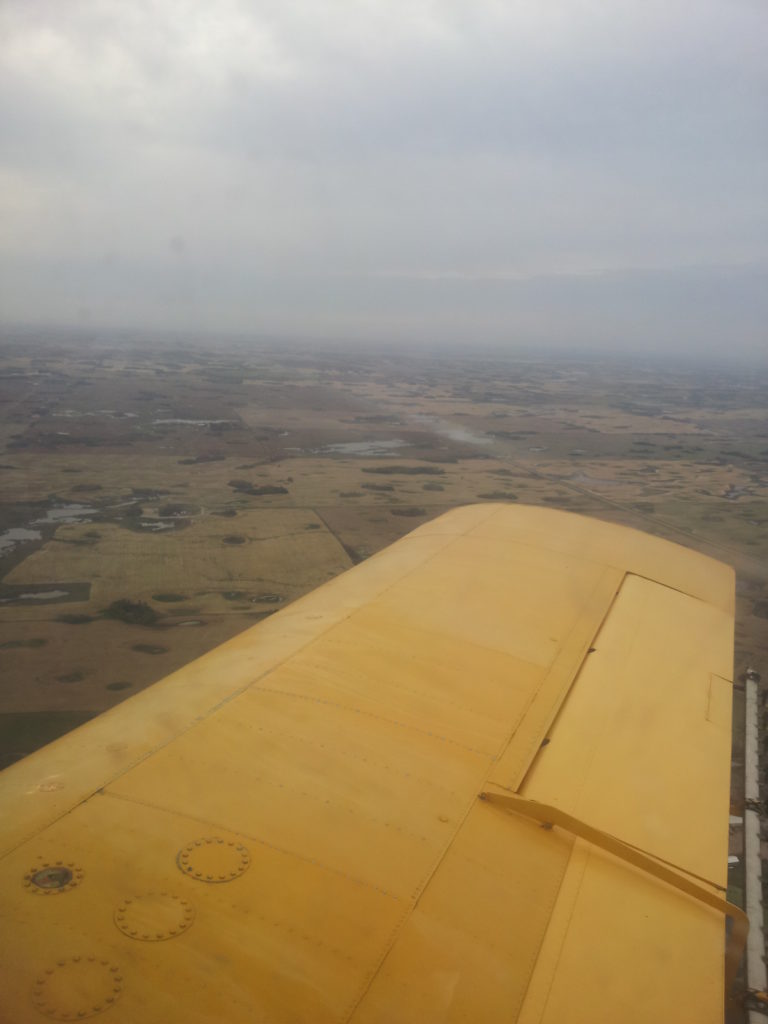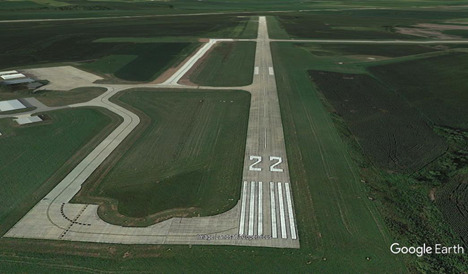Estimated reading time 11 minutes, 18 seconds.
Editor’s note: This is part 2 of “a trip to…” series by Ted Delanghe, where the former Air Force pilot recalls extraordinary memories and lessons learned from his time spent flying over 50 different aircraft types around the world. Click to read part 1, part 3, and part 4.
It was late September 2016, and the phone rang. It was a good friend of mine, Norm Colhoun — farmer, businessman, and aviation entrepreneur from the small town of Lumsden, about 20 kilometers northwest of Regina, Saskatchewan.
“Can you ferry a Garrett-powered Thrush to Shenandoah tomorrow?”
“Sure,” I said. “Where is Shenandoah?”
This one was in Iowa. That night I checked the route over – it would take four legs of about 200 nautical miles each. And the weather forecast, while not the sunny skies and light winds I always hope for on such flights, was certainly good enough for the VFR flight. I expected to have to dance around a bit of weather and gusty winds en route, but all in all, shouldn’t be a problem.

Shenandoah! What a lovely city name, conjuring up images of Southern gentility and a belle beauty in Southern finery, right out of Gone with the Wind.
There’s no such cultured civility with the Thrush. To me, aircraft have their own personalities… The graceful elliptical wing of the Spitfire; the sleek elegance of a Learjet; the lethal profile of an F-22 Raptor; the welcomed good manners of a Cessna 172.
My ride to Shenandoah was no exception. I had flown the Thrush the previous summer, and the only descriptive I had for it was: “The Beast.” It had weathered many seasons of the very demanding profession of ag flying, and the weathering showed. Paint that was once a glimmering yellow-gold was faded and scraped. This was met with small indentations in the fuselage and wings where birds (and perhaps some branches) had met an unruly end. And a blackened arc along the right side where the Garrett engine spewed out hot gases to discolor the fading paint even further.
No artist had a hand in its creation, just engineers who wanted to design a tractor with wings. Not one ounce of elegance, only brute strength and a rock-solid sturdiness befitting its role as a blue-collar working machine. The cockpit, with its Spartan accommodations and “steam-driven” instrumentation, fit well into this mantra.
The Garrett turbine only added to the moniker — temperamental and temperature-sensitive, very unforgiving to an inattentive operator. Its saving grace being a fast throttle response inherent with its direct drive design. But, unlike the the ubiquitous PT-6 turbines that whisper at idle, the Garrett was a real screamer on the ground, as would befit a beast unleashed.
I arrived at Norm’s airstrip just as the sun’s disk was breaking the horizon, with a touch of its warmth on my cheeks to break the chill in the air. It was a bit cool for my light jacket, but I knew I was heading for warmer climes on the southward journey. A slight southeast breeze, which normally would portend of harsh inclement weather courtesy of the seasonal Colorado Low, made me somewhat uneasy, as the system was coming from where I was going.
But a good omen dissipated my concerns. A prairie falcon perched on the tip of the propellor blade was surveying its domain with a royal demeanor. Surely this was a clear sign for a safe and uneventful flight.

Walkaround complete, I bid farewell to the falcon and lit up the Garrett, its wailing scream rudely breaking the calm silence. On to the runway, full throttle, and quickly airborne.
First stop was Minot, North Dakota, to check in with U.S. Customs. They were ready for me, and we quickly filled out the required paperwork, ready for the next leg another 200 nm to the east.
Taxiing out, I noticed an odd burnt-orange hue to the atmosphere ahead. I sensed an agitation in the air, and rechecking the forecast had upped the possibility of gusty winds and blowing dust — just meaning it might be a bumpy ride and limited visibilities. But within minutes after departure, at around 2,000 feet AGL, I encountered the solid wall of dust I had seen earlier, along with a vengeful tumult that tossed the Thrush around with a forceful malice that really got my attention.
I cinched down the lap and shoulder harnesses, working hard on stick and rudder just to keep a level keel. Ag flying is by nature a solitary enterprise — one seat, one pilot — and when you encounter the raw strength and capricious nature of the skies, you feel like a miniscule speck amidst its unremitting vastness. I am certain that sailors feel the same way when riding out a storm on the high seas.
I couldn’t see facing another hour of struggle, so the best option was to climb above it. So up I went, higher and higher, the surging dust and wind finally loosening their grip on me around 9,000 feet. But as always, the unexpected becomes the expected; one of the first things aspiring pilots learn is that the atmosphere cools with altitude. At my new cruising altitude, that meant the ambient temperature was close to 0 C (32 F). I distinctly remember my feet being painfully cold, and as the Thrush hadn’t been designed with a heater, it was only going to get worse.

One hour left to the next stop, so it was sit and freeze, or return into the maelstrom to continue the pummeling. Down I went to see what new tricks Mother Nature would bring forth. To my very pleasant surprise, it appeared I was beyond the severe turbulence, with just a touch of bumpiness in the air. I could see a row of thunderstorms in the far distance in the southeast direction of my route, but they were widely spaced with lots of clearance between. Should be no problem. And it was warm!
Two quick refuelling stops at Aberdeen and Sioux Falls, South Dakota, and I was on to the last short leg of 160 nm. I was in the “Corn State!” The fall harvest had just begun, the stark barrenness of the husked terraced fields standing in sharp contrast to those still hanging heavy with a mature crop.
Just one more item to check before arrival, and that was what to do about the towering and very active Cumulonimbus clouds directly between me and Shenandoah. The weather gods must have been tired that day, for the cells looked like identical twins, stretching high overhead with their sinister anvil heads. I could see the airport just beyond them, and since they were spaced a few miles apart, I thought to take a direct route between them to my destination.
The weather gods may have been tired, but they definitely weren’t asleep at the helm. Just as I had established my heading, two huge lightning bolts arced between the towering sentinels. I got the message, “No one passes here!” My new and much safer route meant taking a brief detour to the north and east, with a little bit of sightseeing as part of the price of admission.

Swinging around the northern cell, giving it a wide berth, I rolled out a few miles back to final Runway 22 at Shenandoah. The beast had arrived in the land of beauty, the new owner eagerly awaiting my arrival on the rain-soaked tarmac.









Great read Ted! I always knew you were a great pilot but I never knew you were such a wordsmith.
What a great descriptive article Ted, what a gifted story teller you are. I am however, amazed at the limited adjectives chosen to describe Mr Colhoun. Look forward to the next round!
Great story as always Ted. You sure can spin a yarn. I’m assuming, knowing Norm, you bought a car or truck at the local auction and drove it home?
Hi Ted. Great article and great descriptive writing. I enjoyed the article. Well done
Cheers!
John G